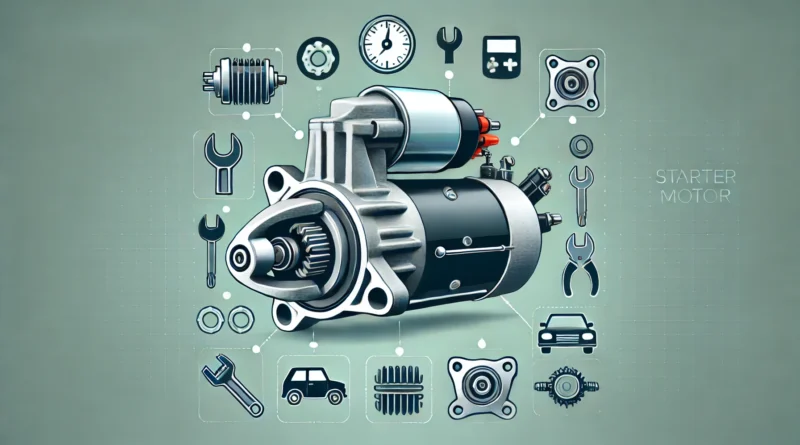What is a Starter Motor? Understanding Its Role in Your Vehicle
In this article, we’ll explore everything you need to know about starter motors, including their function, common problems, and what to do if yours fails. The starter motor is a crucial component in your vehicle’s engine, responsible for getting your car up and running. Without it, your engine wouldn’t be able to start, leaving you stranded. Understanding what a starter motor is, how it works, and what can go wrong with it can help you diagnose issues early and ensure your vehicle remains reliable.
What is a Starter Motor?
It’s an electric motor that is responsible for turning the engine over and starting the combustion process. When you turn the key in the ignition or press the start button in a modern vehicle, the starter engages with the engine’s flywheel to spin the engine’s crankshaft. This action begins the process of combustion, allowing the engine to start running on its own.
How Does a Starter Work?
The starter motor is powered by the vehicle’s battery and is activated when you turn the ignition key or press the start button. Here’s a step-by-step breakdown of how it works:
- Engaging the Solenoid: When you turn the ignition key, an electrical signal is sent to the starter solenoid, which acts as a switch. The solenoid engages and allows electrical current to flow from the battery to the starter.
- Driving the Pinion Gear: The starter is equipped with a small gear called the pinion gear. When the starter is activated, the pinion gear extends outwards and meshes with the engine’s flywheel.
- Turning the Flywheel: The starter then spins the pinion gear, which in turn rotates the flywheel. The flywheel is connected to the crankshaft, so as it spins, it turns the crankshaft, initiating the engine’s combustion process.
- Disengaging After Start: Once the engine starts running, the starter automatically disengages, and the pinion gear retracts back into the motor. The engine then runs independently of the starter.
Why is the Starter Motor Important?
It’s essential for getting your vehicle’s engine running. Without it, the engine wouldn’t be able to start, and you wouldn’t be able to drive your car. The starter must work reliably every time you start your vehicle, making it a critical component of your car’s ignition system.
Common Problems with Starter Motors
Like any mechanical component can experience wear and tear over time. Here are some common problems associated:
1. Starter Doesn’t Engage
If you turn the key and hear nothing or only a clicking sound, it could indicate that the starter isn’t engaging with the flywheel. This can be caused by a dead battery, a faulty solenoid, or a problem with the ignition switch.
2. Grinding Noise
A grinding noise when starting your vehicle often indicates that the pinion gear is not properly engaging with the flywheel. This can happen if the gear is worn out or if the flywheel teeth are damaged. Continuing to start the car with this issue can cause further damage to both the starter motor and the flywheel.
3. Starter Motor Spins but Engine Doesn’t Crank
If the starter motor spins but the engine doesn’t crank, it could mean that the pinion gear is not extending far enough to engage the flywheel. This issue may be due to a mechanical failure within the starter motor or a problem with the solenoid.
4. Intermittent Starting Issues
If your car starts sometimes but not others, it could indicate an intermittent problem with the starter motor or its electrical connections. Loose or corroded battery terminals, a faulty ignition switch, or a failing solenoid can cause these sporadic issues.
What to Do If Your Starter Motor Fails
If you suspect that your starter is failing, it’s important to diagnose and address the issue promptly to avoid being stranded. Here’s what you should do:
1. Check the Battery
Before assuming the starter is the problem, check the battery. A weak or dead battery is a common cause of starting issues. Ensure the battery terminals are clean and securely connected. If the battery is old or not holding a charge, it may need to be replaced.
2. Listen for Sounds
Pay attention to any unusual sounds when trying to start your vehicle. Clicking sounds often indicate a solenoid or battery issue, while grinding noises may point to problems with the starter or flywheel.
3. Inspect Electrical Connections
Check the electrical connections between the battery, starter, and solenoid. Look for loose, corroded, or damaged wires that could be affecting the starters operation.
4. Consult a Professional Mechanic
If you’ve checked the battery and connections and are still experiencing starting issues, it’s time to consult a professional mechanic. They can perform a thorough diagnostic to determine if the starter motor is faulty and needs to be repaired or replaced.
Can You Replace a Starter Motor Yourself?
Replacing a starter can be a challenging task, depending on the make and model of your vehicle. It often involves working in tight spaces and removing several components to access the starter. If you’re confident in your mechanical skills and have the right tools, you can attempt to replace the starter motor yourself. However, if you’re unsure, it’s best to leave this job to a professional mechanic.
Conclusion
The starter motor is a vital component of your vehicle’s ignition system, responsible for starting the engine and getting you on the road. Understanding how it works and recognizing the signs of a failing starter motor can help you address issues before they leave you stranded. Regular maintenance, including checking your battery and electrical connections, can help ensure that your starter motor remains reliable. If you experience any starting issues, don’t hesitate to consult a professional mechanic to diagnose and resolve the problem.
Buying a used VW. Buying used vauxhall, BMW, Jaguar, Ford, Volvo, Range rover, Bentley, Aston Martin, Porsche, Ferrari, Lamborghini, Maserati, Hyundai, Tesla, Honda, Pagani

